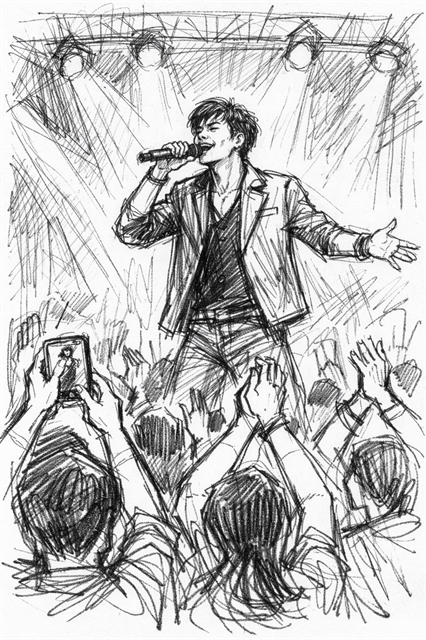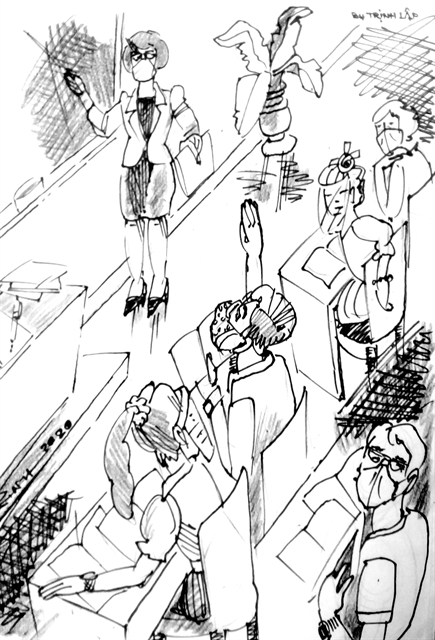 Talk Around Town
Talk Around Town

The first week back at school for students in Việt Nam coincides with the first hot weather spell in the northern part of the country. Early warnings of stagnant air-conditioned spaces being an environment for viruses, in particular the novel coronavirus to inhabit and develop, have prompted many teachers and parents not to use air-conditioners, even when outside temperatures reach as high as 38-40 degrees Celsius.
by Nguyễn Mỹ Hà
The first week back at school for students in Việt Nam coincides with the first hot weather spell in the northern part of the country. Early warnings of stagnant air-conditioned spaces being an environment for viruses, in particular the novel coronavirus to inhabit and develop, have prompted many teachers and parents not to use air-conditioners, even when outside temperatures reach as high as 38-40 degrees Celsius.

|
| Illustration by Trịnh Lập |
"You can use air conditioners when it gets too hot," said Deputy Prime Minister Vũ Đức Đam in his daily briefing from the National Committee for COVID-19 Prevention and Control. "After school and early in the morning, you'll have to open the doors and windows to get fresh air into the classrooms and then use air conditioners accordingly."
The government's decision to send students back to school was widely welcomed by parents, teachers and above all, the students themselves.
"Nhất quỷ, nhì ma, thứ ba học trò," or the devils rank first, then come the ghosts and third school students, is a popular Vietnamese saying. It means that the school kids are mischievous who never stop trying to drive their parents and teachers up the wall.
Kids are famous for making great excuses to skip class.
But now as Viêt Nam has applied strict social distancing due to the new coronavirus, students have been staying at home for three months.
The threat of coronavirus has managed to do what educators and parents have been trying for years: make kids want to go to school.
On Monday, hundreds of thousands of students in Hà Nội went back to school wearing face masks, armed with hand sanitiser to clean their tables, seats and lockers.
When I dropped off my kids at the gate on Monday morning, I was touched to see another mother holding a basket of flowers in her hand with a poster that said "Welcome back to school".
Before the children were reunited with their teachers and friends, parents had an online meeting with a check list of things to do.
They decided their children should wear face masks while they are in school, and carry some spare ones in case of need. They should also carry hand sanitiser at all times and maintain a 1-metre distance with friends and teachers.
At public schools, all the canteens have been closed. Students have to bring their own meals. They're not allowed to order food and are not advised to share food and drinks with friends.
All extracurricular activities, including sport, music, dance and cooking, have been suspended.
At my children's schools, there are 50 clubs and many students work hard to get a place at the school just because they want to be in their dream clubs.
At Hà Nội's private Marie Curie School, the principal took to the stage to welcome students back.
But children being children, it's really hard to make them remember the new rules they should be following so they become a habit. I keep repeating to my children: "No more sharing food when you or anyone else has touched it. No more having a sip of tea from your friends' mugs, or offering them your mug."
This week marks another scorching summer in Hà Nội, with temperatures forecast to be 36-40 degrees Celsius. "You're not supposed to use air-conditioners," has been a common guideline for schools to employ. But the classrooms have been empty for three months, and they have been cleaned, polished and sanitised. Kids and the teachers need to stay cool to study and teach.
Prior to the back-to-school decision, Việt Nam has had three weeks of no new cases in the community in the whole country. But when the kids go back to schools, concerns still worry parents.
Usually the months of May and June are the hottest in Hà Nội and the north, while in the south it's starting to be the cooler rainy season.
Pictures of the first day back at school show small children in primary schools wearing face masks inside face shields. The protective gear, donated to a class in Đà Nẵng by a wealthy parent, cost VNĐ32 million (US$1,500).
"What on earth were they thinking?" asked a netizen after seeing primary school children in Hà Nội, Đà Nẵng and Hồ Chí Minh City wearing face masks and shields in 35-plus degree Celsius heat in no air-conditioned classrooms. "You adults need to try wearing them yourselves sitting in a classroom for four hours!"
An ophthalmologist added that face shields made of clear plastic would damage small children's vision if they wore them for too long.
The National Steering Committee for COVID-19 Prevention and Control on Wednesday clarified that students were not required to wear face masks in classrooms but were advised to wear them during breaks and to avoid contact with friends in other classes.
After many delays, students in Hà Nội and Hồ Chí Minh City are finally back at school.
Public school teachers have been paid for teaching online, but private school teachers, especially in kindergartens and primary schools, have really suffered.
"It's impossible to teach small children online when hands-on caring and training are a must," said a private kindergarten teacher.
Secondary, high school and college students have been learning online, but only for some subjects and to some extent. They need actual academic training and Q&As.
"All the main subjects including maths, Vietnamese, physics and chemistry should be taught in class in the morning," said a high school teacher during our online meeting. "Other subjects can be taught online in the afternoon," she said.
Due to classroom distancing, one class must be divided into two so teachers are having to work twice as hard. That's why online classrooms are still needed.
"Mum, I'm so excited I cannot sleep!" whispered my six grader. "Tomorrow, I finally get to wear my new school bag and shoes. They've been waiting for more than 100 days now since Lunar New Year holiday!"
I then texted a message to the class teacher-parent group: "Wishing you all a happy time at school." VNS




